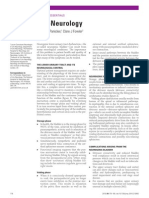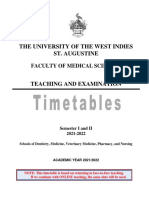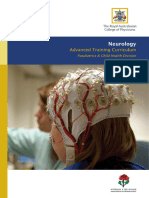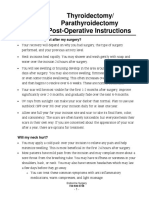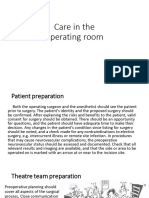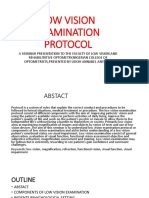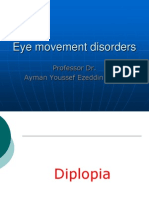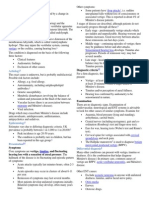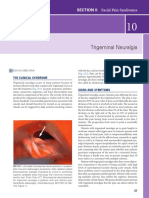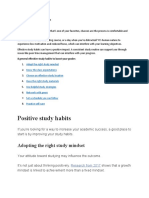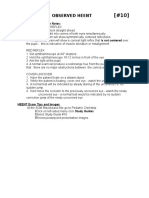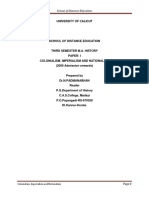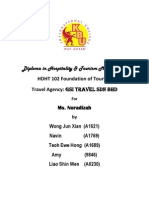0 ratings0% found this document useful (0 votes)
639 viewsStudy Less, Study Smart
The document summarizes Marty Lobdell's "Study Less, Study Smart" lecture which provides 7 tips for effective studying. The tips include breaking studying into short focused sessions with breaks, creating a dedicated study space, actively engaging with material by putting concepts in your own words, taking expanded notes after class, teaching others to reinforce learning, using textbooks through methods like SQ3R, and employing mnemonics for memorizing facts. The document advocates for active learning strategies over passive reading and emphasizes applying concepts from the lecture to improve studying.
Uploaded by
GemCopyright
© © All Rights Reserved
We take content rights seriously. If you suspect this is your content, claim it here.
Available Formats
Download as PDF, TXT or read online on Scribd
0 ratings0% found this document useful (0 votes)
639 viewsStudy Less, Study Smart
The document summarizes Marty Lobdell's "Study Less, Study Smart" lecture which provides 7 tips for effective studying. The tips include breaking studying into short focused sessions with breaks, creating a dedicated study space, actively engaging with material by putting concepts in your own words, taking expanded notes after class, teaching others to reinforce learning, using textbooks through methods like SQ3R, and employing mnemonics for memorizing facts. The document advocates for active learning strategies over passive reading and emphasizes applying concepts from the lecture to improve studying.
Uploaded by
GemCopyright
© © All Rights Reserved
We take content rights seriously. If you suspect this is your content, claim it here.
Available Formats
Download as PDF, TXT or read online on Scribd
You are on page 1/ 6
Study Less, Study Smart
@TomFrankly’s detailed notes
These are my notes from Marty Lobdell’s hour-long “Study Less, Study Smart” lecture,
which is on YouTube here: { HYPERLINK "https://www.youtube.com/watch?v=IlU-
zDU6aQ0" }
How I went about learning the content of this lecture:
Set the video’s playback speed to 1.5x
Paused frequently to take Flow-style notes on notebook paper
o This pausing probably increased the total watch time back up to the video’s original
1-hour playback time, but my method of watching it at a faster speed and pausing to
take notes resulted in better notes.
Immediately after, I translated the notes from my notebook to this Outline-style
document
o This was mainly done for the benefit of readers, as my notes are chicken scratch. But
it also serves to re-encode some of what I learned, as you’ll see from one of Dr.
Lobdell’s tips
My purpose was to understand the content of the lecture well enough that I could
create a 6-minute video summary of it for students who don’t want to view the whole
thing. You can watch my summary here: { HYPERLINK
"https://www.youtube.com/watch?v=23Xqu0jXlfs" }
Notes start here.
The lecture is broken down into 7 main tips:
1. Break studying down into chunked sessions
2. Create a dedicated study area
3. Study actively (and sleep well)
4. Take smart notes and expand on them right after class
5. Summarize/teach what you learn
6. Use your books correctly - SQ3R method
7. Use mnemonics to study effectively
Break studying down into chunked sessions
How long can a typical freshman read and retain what they’re learning?
o Med students reported 4-5 hours - not typical
o Avg of UMich study: 25-30 minutes for both
Reading
Lectures
o Classes are 50 minutes, but most learning will only happen in first 30
“Study more” is not helpful advice
Efficiency tapers off after 20-30 minutes
o After that, it’s just wasted time
The fix? Take breaks.
o “The moment you start to slide, you’re shoveling against the tide."
o Taking a 5-minute FUN break resets the session and brings your efficiency back up
We tend to do more of what is reinforced and rewarded
o Less of what is punished, ignored, or ineffective
Reinforce study sessions with breaks and FUN REWARDS once the whole thing is done
o As you do this, you’re training yourself to study and your sessions can start
becoming longer.
Create a dedicated study area
Who has a true “study??”
o Most students study in bedrooms, kitchen or dining tables, or common areas
o In bedroom, the bed starts to “call” like Greek sirens
The context/environment largely determines the action you’ll take
o example: questions asked in class
If asked to a group, you raise your hand
If asked to you, you respond verbally
This response is pretty much automatic because you’re conditioned to do it
University of Hawaii study
o Biggest study problem: “We can’t get into it."
o Experiment - lamp in dorm room gets the label, “Study lamp"
desk turned away from the bed
That desk and lamp is now only used for studying
When studying, the lamp goes on.
At first sign of distraction, the lamp goes OFF and student walks away
Those who did this had an avg. 1.0 GPA increase over the control group
Music - should be truly background noise.
o Don’t be trading your attention between studying and singing along
Aside about application
“If it doesn’t change your behavior, you haven’t learned it"
Try at least 1 or 2 things you learn from this, else it’s useless
Study actively (and sleep well)
“The more active you are in your learning, the more effective you’ll be."
o Studying is NOT reading over and over - rote memorization can work for some, but
for most of us it’s ineffective
The best way to study - ask yourself, “What am I learning?
o Concepts - “What does this bone do in the body?"
o Facts - “What’s the name of this bone?"
Most professors are concerned that you learn concepts.
o Once grasped, they stay with you forever
o Facts can fade away, by contrast
But we have Google to look them up again
o Marty’s daughter knew all the lyrics to a song but didn’t know what it was about.
Facts vs. concepts
However, teachers test over both facts and concepts
o To learn both, put the concept IN YOUR OWN WORDS
o If you can’t, you don’t understand it!
Marty’s memory test - which string of letters can you remember better?
o YTHURSPHDAAYP
o HAPPY THURSDAY
o Same letters, different order - one has actual meaning
Deep application vs. superficial thinking
o Marty asked one group to count the number of vowels in each of 30 words
o Another group was asked to evaluated usefulness of each in a survival situation
o Short-term memory (about 20-30 seconds) was then dumped with
name/date/phone number exercise
o Afterward, students were asked how many of the 30 words they recalled
Vowel-counting group: 5/30
Survival-usefulness group: 10/30
“What is the meaning… of meaning?"
o Something is meaningful if it relates to something you ALREADY KNOW
It’s like a file system or database - new entries are easier to find if they have data that
links to already existing entries
Teachers try to add meaning to concepts through:
o Stories
o Examples
o But these don’t always work for you, so you must work to tease out meaning for
yourself
How to “tease out” meaning
o Study groups
multiple people = seeing problems from different angles
o Don’t make highlighting mistakes
Highlighting can be dangerous. You highlight when reading, then come back and see
the highlighted sections and say, “I remember that!"
Recollection vs. Recognition
It’s very easy to confuse simple recognition for actual recollection.
Look at an old magazine you’ve seen before - you’ll probably recognize the ads and
picture
but unless you can PREDICT what’s on the next page, you don’t actually recall what’s in
the mag
Same with highlighted text - you recognize it from before, but can you recall it truly?
This is the danger of highlighting - if you confuse recognition for recall, and you’ve
highlighted the most important facts in the text, then YOU DON’T STUDY THE MOST
IMPORTANT FACTS!
A better way - test yourself. Challenge your recall
This is active learning
You also need to sleep well
o Brain science is revealing that REM cycles are crucial for consolidating and storing
memories
Lack of sleep = studying sabotage
Take smart notes and expand on them right after class
Taking notes is vital, but...
o ASAP after class, you should try to expand on them so they’re more efficiently
encoded.
This puts things in your own words
Only takes about 5 minutes per class, and you save so much study time later
This can be considered increasing Learning Efficiency in my study time equation
If you’re fuzzy on a concept, ask a classmate to see their notes, or ask the professor
o Go to office hours, or ask for clarification at the start of the next class
Summarize/teach what you learn
Best way to learn is to teach others
o reinforces learning
o true test of whether you understand the material
will reveal gaps in your knowledge
No person to teach? Record a podcast or video! Or speak it to an empty chair
Or summarize by writing it.
o Your own words = effective summarization
“80% of your study time is best spent reciting - only 20% should be spent reading."
Use your books correctly - SQ3R method
Textbooks are a powerful tool
o Designed for “pedagogy” - helping you learn
Marty’s recommended reading method: SQ3R
o Survey
o Question
o Read
o Recite
o Review
I (and Cal Newport) don’t think it’s necessary to stick to this system - it’s time-
consuming
o However, individual pieces can be useful
“Survey” - also can be known as “read backward” - go to the end of the chapter, note
vocab and review questions
This primes your brain to pick these things out when reading or scanning
Use mnemonics to study effectively
Mnemonics are great for memorizing facts - better than rote memorization
o Acronyms
ROY G. BIV
Radeo - “right deoxygenated"
Right atrium of heart pumps deoxygenated blood"
o Coined sayings
“In 1492, Columbus sailed the ocean blue"
Rhymes are memorable
o Interacting images (Marty’s favorite"
The weirder or more emotionally evocative, the better
Sinkhole to hell with weird demon fish popping out of it - Helsinki, capital of Finland
(fish have fins)
This is one of mine
The car has 4 wheels, and pro circuit cars still have 4 wheels
“Car” - carbohydrate and “pro” - protein - each have 4 calories per gram
Cat has 9 lives - rich dude is a “Fat cat” - fat has 9 calories per gram
Want to see the original 7 notebook pages of Flow-style notes I took while watching the
lecture? You’ll find scans of them here: { HYPERLINK "http://collegeinfogeek.com/study-
less-study-smart/" }
You might also like
- Ho - Unit 1 - L9 Human Anatomy - Nervous System100% (1)Ho - Unit 1 - L9 Human Anatomy - Nervous System24 pages
- Survival Guide - FY2: Updated by TSZ Lam, Li (Josephine)No ratings yetSurvival Guide - FY2: Updated by TSZ Lam, Li (Josephine)17 pages
- Sample. Tank Foundation Design: in This SectionNo ratings yetSample. Tank Foundation Design: in This Section50 pages
- Aclc College of Manila, Inc.: Republic of The Philippines Department of EducationNo ratings yetAclc College of Manila, Inc.: Republic of The Philippines Department of Education1 page
- Abnormal Eeg Patterns: Prepared by Joel F. Lubar PH.DNo ratings yetAbnormal Eeg Patterns: Prepared by Joel F. Lubar PH.D11 pages
- The Vestibular System A Sixth Sense 1st Edition Jay M Goldberg pdf download100% (2)The Vestibular System A Sixth Sense 1st Edition Jay M Goldberg pdf download73 pages
- Migraine Headaches - University of Maryland Medical Center PDFNo ratings yetMigraine Headaches - University of Maryland Medical Center PDF22 pages
- ENT Differential Diagnosis and History Taking NotesNo ratings yetENT Differential Diagnosis and History Taking Notes12 pages
- Neurology Paediatrics Advanced Training CurriculumNo ratings yetNeurology Paediatrics Advanced Training Curriculum39 pages
- Instant ebooks textbook (Ebook) Essential Skills for a Medical Teacher by Ronald Harden, Jennifer M Laidlaw ISBN 9780702078552, 0702078557 download all chapters100% (6)Instant ebooks textbook (Ebook) Essential Skills for a Medical Teacher by Ronald Harden, Jennifer M Laidlaw ISBN 9780702078552, 0702078557 download all chapters71 pages
- Thyroidectomy/ Parathyroidectomy Post-Operative InstructionsNo ratings yetThyroidectomy/ Parathyroidectomy Post-Operative Instructions10 pages
- Eye Movement Disorders: Professor Dr. Ayman Youssef Ezeddin Eassa100% (1)Eye Movement Disorders: Professor Dr. Ayman Youssef Ezeddin Eassa25 pages
- ICSI - Diagnosis and Treatment of Headache100% (1)ICSI - Diagnosis and Treatment of Headache91 pages
- Resident - Handbook - January 2016 - Final PDFNo ratings yetResident - Handbook - January 2016 - Final PDF205 pages
- Interdisciplinary Plan of Care and Patient EducationNo ratings yetInterdisciplinary Plan of Care and Patient Education26 pages
- Ear Surgery: Tympanoplasty, Mastoidectomy: Patient Postoperative Instructions and InformationNo ratings yetEar Surgery: Tympanoplasty, Mastoidectomy: Patient Postoperative Instructions and Information4 pages
- Red Eye: A Guide For Non-Specialists: Medicine100% (1)Red Eye: A Guide For Non-Specialists: Medicine14 pages
- Infogeelk Notes From Marty Lobdell Study Less Study Smart Video - CompressNo ratings yetInfogeelk Notes From Marty Lobdell Study Less Study Smart Video - Compress8 pages
- The Holy Grail Forex Trading System Foreign Exchange Day Trading Was This The Ultimate Financial Currency Daytrading Strategy James Windsor download100% (1)The Holy Grail Forex Trading System Foreign Exchange Day Trading Was This The Ultimate Financial Currency Daytrading Strategy James Windsor download33 pages
- Laws On Child Support in The PhilippinesNo ratings yetLaws On Child Support in The Philippines2 pages
- Colonialism, Imperialism and Nationalism PDFNo ratings yetColonialism, Imperialism and Nationalism PDF283 pages
- 2024-11-17-01-12-07-For-Muslims-CSS-2025-Batch-1No ratings yet2024-11-17-01-12-07-For-Muslims-CSS-2025-Batch-11 page
- Format For The Written Analysis of The CaseNo ratings yetFormat For The Written Analysis of The Case1 page
- A48970353 - 28750 - 6 - 2023 - QTT201 Ca3No ratings yetA48970353 - 28750 - 6 - 2023 - QTT201 Ca34 pages
- The Theory of Public Administration (Presentation)No ratings yetThe Theory of Public Administration (Presentation)191 pages
- Martha M. Smith, A/k/a/ Martha M. Saemenes v. Butler County Jail and Attorney General of Kansas, 968 F.2d 21, 10th Cir. (1992)No ratings yetMartha M. Smith, A/k/a/ Martha M. Saemenes v. Butler County Jail and Attorney General of Kansas, 968 F.2d 21, 10th Cir. (1992)2 pages
- Provided by Liberty University Digital CommonsNo ratings yetProvided by Liberty University Digital Commons105 pages
- Diploma in Hospitality & Tourism Management: HDHT 102 Foundation of Tourism Travel Agency: GSI Travel SDN BHDNo ratings yetDiploma in Hospitality & Tourism Management: HDHT 102 Foundation of Tourism Travel Agency: GSI Travel SDN BHD9 pages
- Load - Even Semester AY2012-13 Department of Chemical EngineeringNo ratings yetLoad - Even Semester AY2012-13 Department of Chemical Engineering7 pages
- Definitive Guide of The Vertical Garden - Vertical Gardens BookNo ratings yetDefinitive Guide of The Vertical Garden - Vertical Gardens Book284 pages
- Initiate and Complete A Journal Entry Document Via Park Document (Document Types SA or ZB)No ratings yetInitiate and Complete A Journal Entry Document Via Park Document (Document Types SA or ZB)18 pages















